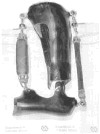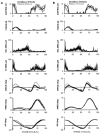An ankle-foot orthosis powered by artificial pneumatic muscles
- PMID: 16082019
- PMCID: PMC1351122
- DOI: 10.1123/jab.21.2.189
An ankle-foot orthosis powered by artificial pneumatic muscles
Abstract
We developed a pneumatically powered orthosis for the human ankle joint. The orthosis consisted of a carbon fiber shell, hinge joint, and two artificial pneumatic muscles. One artificial pneumatic muscle provided plantar flexion torque and the second one provided dorsiflexion torque. Computer software adjusted air pressure in each artificial muscle independently so that artificial muscle force was proportional to rectified low-pass-filtered electromyography (EMG) amplitude (i.e., proportional myoelectric control). Tibialis anterior EMG activated the artificial dorsiflexor and soleus EMG activated the artificial plantar flexor. We collected joint kinematic and artificial muscle force data as one healthy participant walked on a treadmill with the orthosis. Peak plantar flexor torque provided by the orthosis was 70 Nm, and peak dorsiflexor torque provided by the orthosis was 38 Nm. The orthosis could be useful for basic science studies on human locomotion or possibly for gait rehabilitation after neurological injury.
Figures




Similar articles
-
An improved powered ankle-foot orthosis using proportional myoelectric control.Gait Posture. 2006 Jun;23(4):425-8. doi: 10.1016/j.gaitpost.2005.05.004. Epub 2005 Aug 10. Gait Posture. 2006. PMID: 16098749
-
A pneumatically powered knee-ankle-foot orthosis (KAFO) with myoelectric activation and inhibition.J Neuroeng Rehabil. 2009 Jun 23;6:23. doi: 10.1186/1743-0003-6-23. J Neuroeng Rehabil. 2009. PMID: 19549338 Free PMC article.
-
Mechanical performance of artificial pneumatic muscles to power an ankle-foot orthosis.J Biomech. 2006;39(10):1832-41. doi: 10.1016/j.jbiomech.2005.05.018. Epub 2005 Jul 14. J Biomech. 2006. PMID: 16023126
-
Contributions to the understanding of gait control.Dan Med J. 2014 Apr;61(4):B4823. Dan Med J. 2014. PMID: 24814597 Review.
-
Slacking by the human motor system: computational models and implications for robotic orthoses.Annu Int Conf IEEE Eng Med Biol Soc. 2009;2009:2129-32. doi: 10.1109/IEMBS.2009.5333978. Annu Int Conf IEEE Eng Med Biol Soc. 2009. PMID: 19964581 Review.
Cited by
-
Application of Wearable Sensors in Actuation and Control of Powered Ankle Exoskeletons: A Comprehensive Review.Sensors (Basel). 2022 Mar 14;22(6):2244. doi: 10.3390/s22062244. Sensors (Basel). 2022. PMID: 35336413 Free PMC article. Review.
-
Powered ankle-foot orthoses: the effects of the assistance on healthy and impaired users while walking.J Neuroeng Rehabil. 2018 Oct 1;15(1):86. doi: 10.1186/s12984-018-0424-5. J Neuroeng Rehabil. 2018. PMID: 30285869 Free PMC article. Review.
-
A pneumatic power harvesting ankle-foot orthosis to prevent foot-drop.J Neuroeng Rehabil. 2009 Jun 16;6:19. doi: 10.1186/1743-0003-6-19. J Neuroeng Rehabil. 2009. PMID: 19527526 Free PMC article.
-
Biomechanics and energetics of walking in powered ankle exoskeletons using myoelectric control versus mechanically intrinsic control.J Neuroeng Rehabil. 2018 May 25;15(1):42. doi: 10.1186/s12984-018-0379-6. J Neuroeng Rehabil. 2018. PMID: 29801451 Free PMC article.
-
A Highly Backdrivable, Lightweight Knee Actuator for Investigating Gait in Stroke.IEEE Trans Robot. 2009 Jun;25(3):539-548. doi: 10.1109/TRO.2009.2019788. IEEE Trans Robot. 2009. PMID: 22563305 Free PMC article.
References
-
- Andersen JB, Sinkjaer T. An actuator system for investigating electrophysiological and biomechanical features around the human ankle joint during gait. IEEE Transactions on Rehabilitation Engineering. 1995;3:299–306.
-
- Andersen JB, Sinkjaer T. Mobile ankle and knee perturbator. IEEE Transactions on Bio-medical Engineering. 2003;50:1208–1211. - PubMed
-
- Blaya JA, Herr H. Adaptive control of a variable-impedance ankle-foot orthosis to assist drop-foot gait. IEEE Transactions on Neural Systems and Rehabilitation Engineering. 2004;12:24–31. - PubMed
-
- Davis S, Tsagarakis N, Canderle J, Caldwell DG. Enhanced modelling and performance in braided pneumatic muscle actuators. International Journal of Robotics Research. 2003;22:213–227.
-
- De Luca CJ. The use of surface electromyography in biomechanics. Journal of Applied Biomechanics. 1997;13:135–163.
Publication types
MeSH terms
Grants and funding
LinkOut - more resources
Full Text Sources
Other Literature Sources

